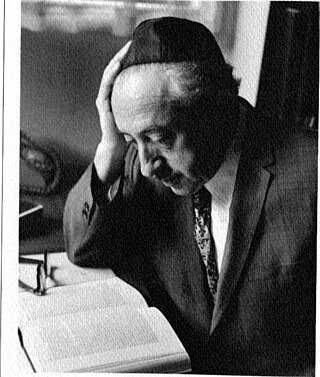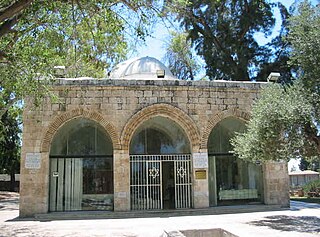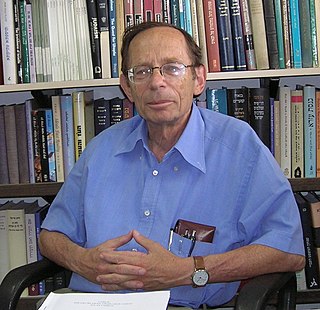Further reading
- Bava Metzia 59b:1, "The Oven of Akhnai"
- Greenwood, Daniel JH. "Akhnai." Utah L. Rev. (1997): 309.
The Oven of Akhnai is a Talmudic story found in Bava Metzia 59a-b which is set around the early 2nd century CE. In the Talmud, the story is told after a discussion of being careful not to mistreat a person and the power of prayers which are said in pain to be heard by God. The story concerns a debate which was held over the halakhic status of a new type of oven. In the course of the rabbinic disagreement, the story expresses differing views of the nature of law and authority, concerns over a fractured and divisive community, and the issue of harming another person through words and actions.
A new type of oven is brought before the Sanhedrin, consisting of tiles separated from one another by sand, but externally plastered over with cement. The rabbis debate whether or not this oven is susceptible to ritual impurity. Rabbi Eliezer ben Hurcanus argues that the oven is ritually pure while the other rabbis, including the nasi Rabban Gamaliel, argue that the oven is impure. When none of Rabbi Eliezer's arguments convince his colleagues, he cries out, "If the halakha is in accordance with my opinion, this carob tree will prove it." At this point, the carob tree leaps from the ground and moves far away. The other rabbis explain that a carob tree offers no proof in a debate over law. Rabbi Eliezer cries out, "If the halakha is in accordance with my opinion, the stream will prove it." The stream begins to flow backwards, but again the other rabbis point out that one does not cite a stream as proof in matters of law. Rabbi Eliezer cries out, "If the halakha is in accordance with my opinion, the walls of the study hall will prove it." The walls of the study hall begin to fall, but are then scolded by Rabbi Joshua ben Hananiah who reprimands the walls for interfering in a debate among scholars. Out of respect for Rabbi Joshua, they do not continue to fall, but out of respect for Rabbi Eliezer, they do not return to their original places.
In frustration, Rabbi Eliezer finally cries out, "If the halakha is in accordance with my opinion, Heaven will prove it." From Heaven a voice is heard, saying, "Why are you differing with Rabbi Eliezer, as the halakha is in accordance with his opinion in every place that he expresses an opinion?" Rabbi Joshua responds, "It [the Torah] is not in heaven" (Deuteronomy 30:12). He responds in this way because the Torah, which was given by God to mankind at Sinai, specifically instructs those who follow it that they are to look to the received Torah as their source and guide. The Torah says, "It is not in heaven, that you should say, 'Who will go up to heaven for us, and get it for us so that we may hear it and observe it?' Neither is it beyond the sea, that you should say, 'Who will cross to the other side of the sea for us, and get it for us so that we may hear it and observe it?' No, the word is very near to you; it is in your mouth and in your heart for you to observe" (Deuteronomy 30:12-14).
Rabbi Joshua's response then expresses the view that the work of law is a work of human activity, and that the Torah itself supports this legal theory. The Torah is not a document of mystery which must have its innate meaning revealed by a minority, but it is instead a document from which law must be created through the human activity of debate and consensus. Rabbinic literature was capable of recognizing differing opinions as having a degree of legitimacy (Yer. Ber. 3b), yet the community remains united and the ruling which is ultimately followed comes through proper jurisprudence. As such, Rabbi Eliezer's miraculous appeals represent a differing legal theory and were outside of proper jurisprudence which meant that they would not be followed. Instead the Jewish community followed the ruling of the majority in this issue and in others. The Talmud asks how God responded to this incident. We are told that upon hearing Rabbi Joshua's response, God smiled and stated, "My children have triumphed over Me; My children have triumphed over Me."
After this incident, the rabbis under Rabban Gamaliel choose to ostracize Rabbi Eliezer from their community. Rabbi Akiva, a student of Rabbi Eliezer, volunteers to bring this news to Rabbi Eliezer. Rabbi Akiva dresses himself in clothes of mourning, and he delicately says to Rabbi Eliezer, "My teacher, it appears to me that your colleagues are distancing themselves from you." Rabbi Eliezer tears his clothes in mourning and begins to cry. It was said that Rabbi Eliezer had the power to destroy the whole world, yet due to the respectful manner in which he was ostracized, only a third of the world's crops were destroyed.
When Rabbi Eliezer was given the news of being ostracized, Rabban Gamaliel was on a boat. A great storm picked up, and Rabban Gamaliel knew that this storm was retribution for the pain caused to Rabbi Eliezer. Rabban Gamaliel proclaims to God, "Master of the Universe, it is revealed and known before You that neither was it for my honor that I acted when ostracizing him, nor was it for the honor of the house of my father that I acted; rather, it was for Your honor, so that disputes will not proliferate in Israel." When he spoke these words, the storm was calmed.
Rabbi Eliezer continued to be in grief over being ostracized from the community. His wife, Ima Shalom (the sister of Rabban Gamaliel), was aware of the power that a prayer said in pain had to be heard. She attempted to interfere with her husband's supplication prayers so that any calls for retribution or bemoaning of his fate would not be heard. Yet one day she was distracted and failed to interfere with Rabbi Eliezer's prayers. At this moment, Rabban Gamaliel died. Rabbi Eliezer asked his wife how she knew that this would happen if he were to pray while in such pain. Ima Shalom explains the sentiment expressed in the discussion preceding the story of the Oven of Akhnai, she says, "This is the tradition that I received from the house of the father of my father: All the gates of Heaven are apt to be locked, except for the gates of prayer for victims of verbal mistreatment."
There are many different themes in the story of the Oven of Akhnai. In the backdrop of the story is the status of Judaism prior to Rabban Gamaliel and the views that developed among the late Pharisaic or early Rabbinic Jews. During the Second Temple period there existed numerous forms of Judaism. Jewish factions during the Second Temple period harshly denounced one another and sometimes were violent towards each other. Following the destruction of Jerusalem in 70 CE, the Rabbis pondered why the destruction occurred. The Rabbis concluded that the Second Temple was destroyed due to "baseless hate" (Yoma 9b). In their retelling of the destruction, they point to divisions and a lack of empathy for one another.
The Rabbis under Rabban Gamaliel sought to unify Judaism and end wanton sectarianism. Rabban Gamaliel's school recognized a degree of validity in varying statements, but chose to follow the more lenient philosophy of the school of Hillel. Jewish leaders like Rabban Gamaliel sought to create a cohesive Jewish community where major issues were settled, a system was in place to decide divisive issues, and minor issues could be tolerated. Rejection of this cooperation and an embrace of sectarianism was condemned in the strongest terms. Rabban Gamaliel himself was known to at times be too forceful in humiliating those who formed divisions. [1]
According to Vered Noam, Rabbi Eliezer sought to reveal an innate halakhah based on revelation and he did not accept proper jurisprudence. In contrast, Rabban Gamaliel and the other rabbis sought to create halakhah through human reason and utilizing proper jurisprudence. Rabbi Eliezer expresses a differing philosophy regarding halakhah and a rejection of following the jurisprudence upon which a cohesive community relies. The dispute is not simply over an oven, but this is a story which reflects two conflicting ideas over the nature of law and possibilities for destabilizing of the community. [2] Rabbi Gamaliel expresses his concerns when calming the storm, stating that the reason for his heavy-handed action was "so that disputes will not proliferate in Israel," the very same disputes which resulted in the destruction of Jerusalem in 70 CE.
At the same time, the story is introduced solely on the basis of a discussion of being careful not to hurt another individual through verbal interactions. Rabban Gamaliel may have had the correct intentions and his philosophies which were necessary for sustaining his community may have won out, yet he still hurt his colleagues through his words and decisions. While much focus is placed on the accuracy of Rabban Gamaliel's position or Rabbi Joshua's statement, the story in the Talmud does not overlook the fact that Rabban Gamaliel's draconian measures may have gone too far. [3]
Scholar Jeffrey Rubenstein has argued that the Oven of Akhnai focuses on the fact that the majority need to take charge over the minority, but in a way that it is fair to all. The majority needs to work off the minority to attend the needs of everyone in the community. [4] Yet, explains Rubenstein, the midrash says there is a limit to what the majority can do. People should not aim to cause someone to experience pain, but instead respect one another.
Geoarchaeologist Beverly Goodman and historian Henry Abramson theorize that the events mentioned in the story are a mythologized version of the effects of a tsunami in the area caused by the 115 Antioch earthquake. [5]
The Oven of Akhnai is one of the best known stories in the Talmud. As a result of the story, the phrase, "Lo Bashamayim Hi," or, "Not in Heaven," is well known among Jews. The phrase and story helps to reflect the Jewish view of law, the feasibility of following the Torah, and the importance of every generation to work to understand the Torah.
The story of the Oven of Akhnai is also notable in being one of the stories where a woman is mentioned having learned Torah and expressing her understandings. [6]
Halakha, also transliterated as halacha, halakhah, and halocho, is the collective body of Jewish religious laws that are derived from the written and Oral Torah. Halakha is based on biblical commandments (mitzvot), subsequent Talmudic and rabbinic laws, and the customs and traditions which were compiled in the many books such as the Shulchan Aruch. Halakha is often translated as "Jewish law", although a more literal translation of it might be "the way to behave" or "the way of walking". The word is derived from the root which means "to behave". Halakha not only guides religious practices and beliefs, it also guides numerous aspects of day-to-day life.
A rabbi is a spiritual leader or religious teacher in Judaism. One becomes a rabbi by being ordained by another rabbi – known as semikha – following a course of study of Jewish history and texts such as the Talmud. The basic form of the rabbi developed in the Pharisaic and Talmudic eras, when learned teachers assembled to codify Judaism's written and oral laws. The title "rabbi" was first used in the first century CE. In more recent centuries, the duties of a rabbi became increasingly influenced by the duties of the Protestant Christian minister, hence the title "pulpit rabbis", and in 19th-century Germany and the United States rabbinic activities including sermons, pastoral counseling, and representing the community to the outside, all increased in importance.

Rabbinic literature, in its broadest sense, is the entire spectrum of rabbinic writings throughout Jewish history. However, the term often refers specifically to literature from the Talmudic era, as opposed to medieval and modern rabbinic writing, and thus corresponds with the Hebrew term Sifrut Chazal. This more specific sense of "Rabbinic literature"—referring to the Talmudim, Midrash, and related writings, but hardly ever to later texts—is how the term is generally intended when used in contemporary academic writing. The terms mefareshim and parshanim (commentaries/commentators) almost always refer to later, post-Talmudic writers of rabbinic glosses on Biblical and Talmudic texts.

Joseph Ber Soloveitchik was a major American Orthodox rabbi, Talmudist, and modern Jewish philosopher. He was a scion of the Lithuanian Jewish Soloveitchik rabbinic dynasty.

Akiva ben Yosef, also known as Rabbi Akiva, was a leading Jewish scholar and sage, a tanna of the latter part of the first century and the beginning of the second century. Rabbi Akiva was a leading contributor to the Mishnah and to Midrash halakha. He is referred to in the Talmud as Rosh la-Hakhamim "Chief of the Sages". He was executed by the Romans in the aftermath of the Bar Kokhba revolt.
In its primary meaning, the Hebrew word mitzvah refers to a commandment commanded by God to be performed as a religious duty. Jewish law in large part consists of discussion of these commandments. According to religious tradition, there are 613 such commandments.
Tannaim were the rabbinic sages whose views are recorded in the Mishnah, from approximately 10–220 CE. The period of the Tannaim, also referred to as the Mishnaic period, lasted about 210 years. It came after the period of the Zugot ("pairs"), and was immediately followed by the period of the Amoraim ("interpreters").

Rabbinic authority in Judaism relates to the theological and communal authority attributed to rabbis and their pronouncements in matters of Jewish law. The extent of rabbinic authority differs by various Jewish groups and denominations throughout history.

Eliezer Berkovits, was a rabbi, theologian, and educator in the tradition of Orthodox Judaism.

Rabban Gamaliel II was a rabbi from the second generation of tannaim. He was the first person to lead the Sanhedrin as nasi after the fall of the Second Temple in 70 CE.

Horayot is a tractate in Seder Nezikin in the Talmud. In the Mishnah, this is the tenth and last tractate in Nezikin; in the Babylonian Talmud the ninth tractate; in the Jerusalem Talmud the eighth. It consists of three chapters in the Mishnah and two in the Tosefta. The tractate mainly discusses laws pertaining to erroneous rulings by a Jewish court, as well as unwitting actions performed by leading authorities of the Jewish people, and the sacrificial offerings that might be brought as a consequence of these actions. The conclusion of the tractate (12a-13b) deals with the prioritization of korbanot in the temple and explores the question of how to quantify human life in emergency situations.
Chazal or Ḥazal, an acronym for the Hebrew "Ḥakhameinu Zikhronam Liv'rakha", refers to all Jewish sages of the Mishna, Tosefta and Talmud eras, spanning from the times of the final 300 years of the Second Temple of Jerusalem until the 7th century CE, or c. 250 BCE – c. 625 CE.
Partnership minyan is a religious Jewish prayer group that seeks to maximize women's participation in services within the confines of Jewish law as understood by Orthodox Judaism. This includes enabling women to lead parts of service, read from the Torah, serve in lay leadership positions, sit in a more gender-balanced format, and in some cases count as part of a minyan ("quorum") of ten men and ten women. Partnership minyanim began in 2002 simultaneously in New York and Jerusalem, and have now spread to over 30 communities in at least five different countries around the world.
Conservative Judaism views halakha as normative and binding. The Conservative movement applies Jewish law to the full range of Jewish beliefs and practices, including thrice-daily prayer, Shabbat and holidays, marital relations and family purity, conversion, dietary laws (kashrut), and Jewish medical ethics. Institutionally, the Conservative movement rules on Jewish law both through centralized decisions, primarily by the Rabbinical Assembly and its Committee on Jewish Law and Standards, and through congregational rabbis at the local level. Conservative authorities produced voluminous Responsa literature.
Eliezer ben Hurcanus or Hyrcanus was one of the most prominent Sages (tannaim) of the 1st and 2nd centuries in Judea, disciple of Rabban Yohanan ben Zakkai and colleague of Gamaliel II, and of Joshua ben Hananiah. He is the sixth most frequently mentioned sage in the Mishnah.
Joshua ben Hananiah, also known as Rabbi Yehoshua, was a leading tanna of the first half-century following the destruction of the Second Temple. He is the seventh-most-frequently mentioned sage in the Mishnah.
Kevod HaBeriyot (Hebrew: כבוד הבריות; literally in Hebrew: "honor [of/due to] the [God's] creations " also variously translated as "individual dignity", "individual honor", or "human dignity" is a concept of Halakha originating in the Talmud which permits exceptions to Rabbinic decrees under certain circumstances. This concept has been used in a number of contemporary Jewish religious-law decisions in Orthodox and Conservative Judaism.
Not in Heaven is a phrase found in a Biblical verse, Deuteronomy 30:12, which encompasses the passage's theme, and takes on additional significance in rabbinic Judaism.
In Jewish law, a Posek is a legal scholar who determines the position of halakha, the Jewish religious laws derived from the written and Oral Torah in cases of Jewish law where previous authorities are inconclusive, or in those situations where no clear halakhic precedent exists.

Gerald Blidstein was professor emeritus of Jewish Philosophy at Israel's Ben-Gurion University of the Negev. He was the Israel Prize laureate in Jewish philosophy (2006) and had been a member of the Israel Academy of Sciences since 2007.